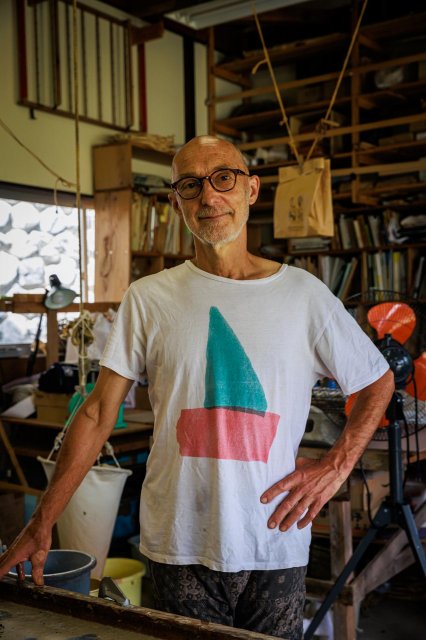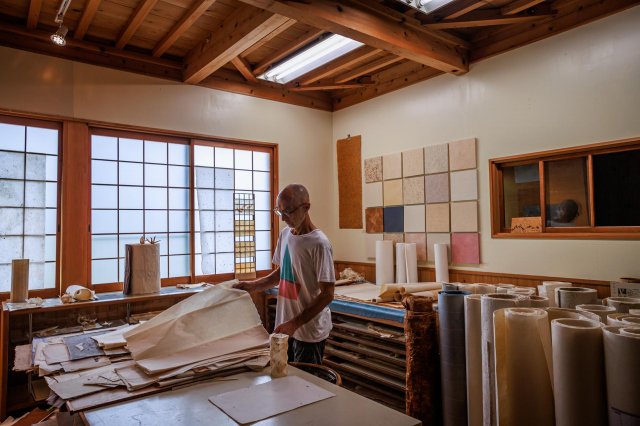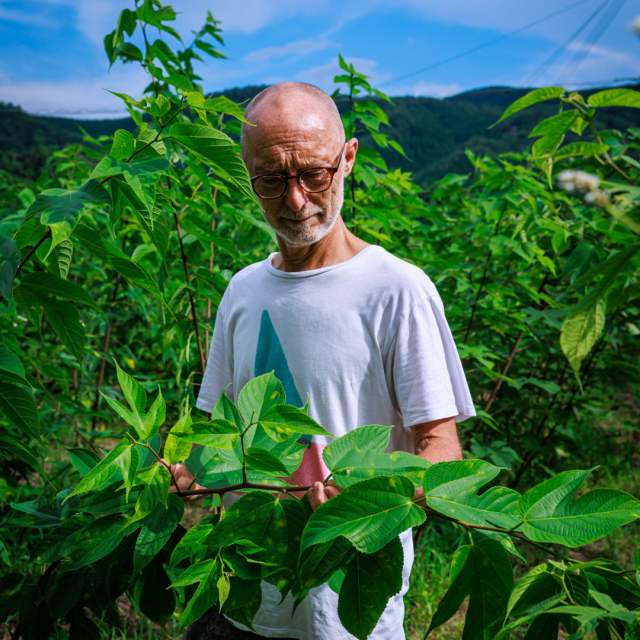- 2022.08.30
-
We are Kochi-ke: Rogier Uitenboogaart
The mark of the papermaker and nature
“The most important work of a papermaker is to show the beauty of the material. Our washi (traditional Japanese paper) might have rough, sun-dried edges, and distinct lines as well as textures of our homegrown fibers you can still touch. By industry standards, those qualities might be considered imperfections, but washi isn’t an industry. It’s a culture. A culture that lives with the rhythm of seasons and yields the inherent power of the elements to create something beautiful.”
“I first came across washi when I was an apprentice bookbinder in my hometown, Amsterdam. Its beauty caught my eye, but the closer I looked, the deeper it drew me in. It was just so different from western handmade paper because you could still see the fibers with which it was made. Washi is not afraid of showing its origins, in fact, that is exactly what it’s meant to do.”
“My fascination toward washi eventually led me here to Japan. Although I visited many papermaking workshops across different regions, nowhere compared to Kochi. Thanks to its pristine and diverse natural landscapes like rivers, mountains and ocean, Kochi was known for producing some of the highest quality washi in Japan. The whole system of fiber production, innovation, and tools, as well as a culture of washi had already existed in the community for more than 1,000 years. But what made me feel like I could actually live here was the kindness and openness of the people. Even though I didn’t speak any Japanese, the local washi masters taught me so much. They let me stay in their workshops and watch their process for hours. Even after I started my own workshop, they were always willing to guide me. Just like family.”
“Over time, I learned that one of the most important aspects for making what we call “good paper” is growing our own fibers. This pushes us to fully connect with nature because we have to know when to plant, harvest and process the fibers throughout the seasons. If you take that away, it becomes more production, rather than what it really is traditionally, which is a lifestyle. Without the use of chemicals or industrial machines, we have to adjust to nature, and that’s what I call going back to basics. It’s the most difficult yet exciting and fun part of the entire process.”
“So at the end, when I’m holding my handmade washi, there’s an aura to it. Every line, texture, color, and shape tells a story straight from the mountains and rivers of Kochi. To me, that’s the perfect mark of the papermaker and nature.”
“We are Kochi-ke (Kochi family)” is all about highlighting the stories of the people who make us proud to call Kochi our home. Whether you are living in Kochi now or only visited once, you are part of the Kochi family
Located in the mountainous town of Yusuhara, Rogier's Washi Studio Kamikoya offers visitors a rare, hands-on experience of making washi. You can also stay at the Japanese-style guest house decorated with Rogier’s handmade washi lamps and wallpaper
Learn more about Kamikoya: https://visitkochijapan.com/en/activities/10158
“The most important work of a papermaker is to show the beauty of the material. Our washi (traditional Japanese paper) might have rough, sun-dried edges, and distinct lines as well as textures of our homegrown fibers you can still touch. By industry standards, those qualities might be considered imperfections, but washi isn’t an industry. It’s a culture. A culture that lives with the rhythm of seasons and yields the inherent power of the elements to create something beautiful.”
“I first came across washi when I was an apprentice bookbinder in my hometown, Amsterdam. Its beauty caught my eye, but the closer I looked, the deeper it drew me in. It was just so different from western handmade paper because you could still see the fibers with which it was made. Washi is not afraid of showing its origins, in fact, that is exactly what it’s meant to do.”
“My fascination toward washi eventually led me here to Japan. Although I visited many papermaking workshops across different regions, nowhere compared to Kochi. Thanks to its pristine and diverse natural landscapes like rivers, mountains and ocean, Kochi was known for producing some of the highest quality washi in Japan. The whole system of fiber production, innovation, and tools, as well as a culture of washi had already existed in the community for more than 1,000 years. But what made me feel like I could actually live here was the kindness and openness of the people. Even though I didn’t speak any Japanese, the local washi masters taught me so much. They let me stay in their workshops and watch their process for hours. Even after I started my own workshop, they were always willing to guide me. Just like family.”
“Over time, I learned that one of the most important aspects for making what we call “good paper” is growing our own fibers. This pushes us to fully connect with nature because we have to know when to plant, harvest and process the fibers throughout the seasons. If you take that away, it becomes more production, rather than what it really is traditionally, which is a lifestyle. Without the use of chemicals or industrial machines, we have to adjust to nature, and that’s what I call going back to basics. It’s the most difficult yet exciting and fun part of the entire process.”
“So at the end, when I’m holding my handmade washi, there’s an aura to it. Every line, texture, color, and shape tells a story straight from the mountains and rivers of Kochi. To me, that’s the perfect mark of the papermaker and nature.”
“We are Kochi-ke (Kochi family)” is all about highlighting the stories of the people who make us proud to call Kochi our home. Whether you are living in Kochi now or only visited once, you are part of the Kochi family
Located in the mountainous town of Yusuhara, Rogier's Washi Studio Kamikoya offers visitors a rare, hands-on experience of making washi. You can also stay at the Japanese-style guest house decorated with Rogier’s handmade washi lamps and wallpaper
Learn more about Kamikoya: https://visitkochijapan.com/en/activities/10158


